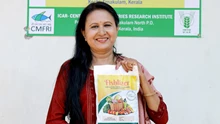
Local Names:
HINDI- Urad dal, TELUGU- Minumulu, TAMIL- Ulundu Paruppu, MALAYALAM- Uzhunnu Parippu, KANNADA- Uddin belle, BENGALI- Masakalai dala.
Introduction:
-
Black gram is one of the most important pulses of India.
-
Black gram is also known as “Urad” in India.
-
It is the main component of Papad, idly and Dosa.
-
It is used as a nutritive fodder for milch cattle.
-
Its deep root system and foliage cover competes with weed effectively and controls soil erosion.
-
It has 13% of total pulses area and 10% of total pulses production in India.
-
It is resistant to adverse climatic conditions.
-
This crop is mainly grown for its protein rich seeds.
LOCATION-
Black bean is a food crop cultivated in the Kumaon region in Uttaranchal and Northern India and in the bordering states and countries of Himalayas.
CLIMATE-
-
Generally it is grown in Kharif /rainy and summer season.
-
But, it is best grown in hot and humid conditions with an ideal temperature between 25-35°c.
-
The main criteria to decide the time of planting is to tally the maturity crop period with the dry weather for higher yield and good quality seeds.
-
Heavy rains are harmful during the time of flowering.
-
Areas having annual rainfall between 60-75 cm are best suited to grow this crop.

Soil Requirement:
-
The crop must have a neutral pH.
-
It is best cultivated in Loam or clay loam soil.
-
Alkaline and saline soils should be avoided
-
Addition of higher organic matter in the soil will help in powerful seed production.
-
The soil must have a good water holding capacity and it should be well drained
-
Black gram grows well in heavy soils which have better moisture.
Land Preparation:
-
The field should be selected where black gram has not been sown in the previous years.
-
This is done to avoid volunteer plants which causes admixture.
-
The fields that are already cultivated with black bean gram will harbor root rot and wilt pathogen.
-
Ploughing should be done in summer with 2-3 harrowing on pre-monsoon for kharif season.
-
The land should be well leveled.
-
5-6 tons of FYM or compost should be mixed at last harrowing.
Selection of Seeds:
-
The seeds used for sowing should be purchased from an authorized source.
-
Seeds should be naturally pure and should have a fine quality.
-
Seeds used for sowing should be effective for a good field stand.
-
Seeds should be checked thoroughly and should be free from insects, pests and diseases.

Time of Sowing:
- Second Half of June (15-30th June) is the perfect time for sowing the seeds.
-
Sowing should start from third week of Feb to First week of April in summers.
-
Avoid late sowing.
Seed Treatment:
-
Seed treating fungicide should be used to reduce infection which is caused by fungal pathogens in the soil.
-
Seeds should be treated with Bavistin & Thiram at 2.5 g/kg seed.
-
For atmospheric N fixation rhizobium culture should be adapted
Seed Rate and Spacing:
-
In kharif season, seed rate is 12-15kg / ha and spacing required is 30×10 cm.
-
In Summer season, seed rate is 20-25kg / ha and spacing required is 20-25×10 cm.
Varieties:
|
VARIETIES |
DURATION |
PRODUCTION (q/ha) |
FEATURES |
|
Pusa-1 |
80-90 |
12-15 |
Resistant to yellow mosaic virus |
|
Azad-1 |
80-90 |
12-14 |
Medium Black Seed |
|
TAU-2 |
70-75 |
10-12 |
Suitable for heavy soil, Seed is Bold |
|
BDU-1 |
70-75 |
10-12 |
Bold Seed |
FERTILIZER MANAGEMENT
The fertilizer dose recommended for black gram is 20:40:40 NPK/ha.
IRRIGATION MANAGEMENT
-
Irrigation is not needed in rainy season.
-
In Summer, irrigation is needed as per critical stages and as per availability of water for irrigation.
-
Frequency of irrigation depends on the soil type and weather.
-
After 10-15 days crops should get irrigation.
-
Moisture in the field is required
HARVESTING & YIELD
-
Collect pods from the plants in 1-2 pickings and dry them on the floor.
-
At the time of harvesting, the crops should be cut and the plants should spread all over the floor to get dry.
-
Plants will turn black and dry and pods will start splitting.
-
Use pliable sticks for beating the plants to save the seeds.
-
After harvesting plants are used as fodder for animals.
-
Yield depends on the type of seeds selected and management of field.
-
800kg-1100kg/acre of yield can be achieved with hybrid varieties.










